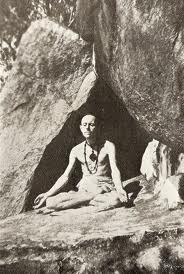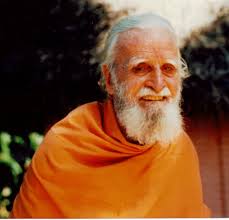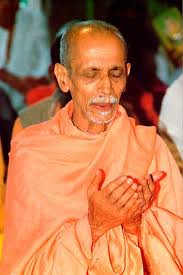So now we turn to the third part of this remarkable essay by Abhishiktananda. In some ways he continues the various themes about sannyasa that he has laid out in the first two parts, and in a sense he gets a bit repetitious and also he becomes somewhat muddled in his focus or so it can seem to a reader–and at the same time evolving into a most controversial and most challenging position with regard both to Hindus and to Christians. So let us begin a close reading of the first few pages. And here he starts with what might look like the first inklings of a “theology of religions.” What he seems to say will not please traditional Christians or cohere with orthodox Catholic theology, nor will it be amenable to orthodox Hindus.
The problem is that Abhishiktananda is trying to draw a circle around what cannot be encircled–as he himself acknowledges again and again. He is trying to put into words what ultimately cannot be put into words, but that doesn’t mean that nothing can be said about this Reality. Quite the contrary. But as that great Christian apophatic master put it: the moment you say something about the Ultimate Transcendent Reality called God, for all practical purposes you have to “unsay” it for the statement to be true. Both the “saying” and the “unsaying” have to be done carefully, thoughtfully, out of deep religious experience, and with profound respect for traditional terms and concepts. So we are not simply playing verbal games, nor dealing in intellectual puzzles that we can solve with enough cleverness. This is one reason why some time ago when I posted a series of reflections on the “Foundations & Fundamentals” of Christian spirituality and mysticism, I made the very first “building block” a sense of God as Ultimate and Absolute Mystery. Unless a person arrives at that realization, sooner or later, he/she will latch on to certain concepts and verbal formulas and images that will not only diminish their spiritual life but totally truncate it.
So Abhishiktananda begins with a basic dynamic of “on the one hand this is true,” but “on the other hand that is true”–in order to avoid simplistic assessment. Abhishiktananda : “Both as an inner experience and as the outward expression of this experience in human life, sannyasa transcends all the dvandvas, or pairs of opposites. It even transcends the fundamental dvandva which religious men have discovered in dharma–adharma…. Even more the sannyasi stands beyond the manifold distinctions and dvandvas which differentiate the various dharmas or religions with their sacred symbols, by whose guidance man strives to reach his goal.“ Now on the other hand he quickly proceeds to explain that he is not implying by this understanding of sannyasa any “facile syncretism” –the notion that all religions are basically all the same and be treated as “equivalent.” However a reader could not be faulted if he/she thought that this was exactly what he is implying! Abhishiktananda goes on to explain his position, but I think he goes on to dig a deeper and deeper hole for himself as far as acceptance goes by orthodox Christians and orthodox Hindus.
Abhishiktananda goes on to explain that each of the great religions of the world is rooted in an “awakening to the Real” in some remarkable person or persons. But this awakening does not take place in a vacuum but in a certain cultural setting and within a particular set of symbols and language possibilities. So the possibility of communicating the meaning of this awakening and symbolically pointing at it is inevitably conditioned by this complex matrix. What Abhishiktananda is doing is separating out a core experience from all the words and symbols that kind of map this experience in limited human terms. He is not saying that all maps are the same but he does emphatically insist that no map is adequate to represent this Reality–because its essential nature is “always beyond.” And it is to this “beyond” that we are drawn to in all the religions. Nor is he saying that the “core experience” of this Absolute Reality that gives rise to each religion is of the same depth or to the same degree or any other kind of sameness. Here he is still within the ambience of Catholic theology with the major exception that Catholic theology would insist that the Catholic symbolic universe points “more fully or more completely” toward this “beyond” and therefore it invites all the other great religions to find their own fulfillment within this ambience. But Abhishiktananda is moving quite far from this position as he explores the meaning of sannyasa.
Abhishiktananda: “Every dharma is for its followers the supreme vehicle of the claims of the Absolute. However, behind and beyond the namarupa, the external features such as creed, rite, etc., by which it is recognized and through which it is transmitted, it bears within itself an urgent call to men to pass beyond itself, inasmuch as its essence is to be a sign of the Absolute. In fact, whatever the excellence of any dharma, it remains inevitably at the level of signs; it remains on this side of the Real, not only in its structure and institutional forms, but also in all its attempts to formulate the ineffable Reality, alike in mythical or in conceptual images. The mystery to which it points overflows its limits in every direction.”
Now we are not going to get into the complex arguments of the theologians that such statements as above imply. In orthodox Catholic theology the “Catholic dharma” would not be seen as simply “at the level of signs”–even its institutional form, “the Church,” becomes the “Body of Christ,” that is it participates in the Reality of the Absolute and not just as a “pointer.” And there are various other arguments about such statements, but Abhishiktananda is not concerned about such arguments–he is totally focused on something else, and here is the core statement of his “theology of religions”: “But in every religion and in every religious experience there is a beyond, and it is precisely this ‘beyond’ that is our goal.” And it is in connection with this “beyond” that sannyasa is to be understood–any other explanation will only obscure the reality and mislead the inquiry into its meaning–such as often happened in western monasticism where the rationale for the life sometime took on the bizarre elements of a superficial piety.
So Abhishiktananda is now better able to locate the phenomenon of sannyasa within the whole realm of religious expression and within the very ground of religion: “ Sannyasa is the recognition of that which is beyond all signs; and, paradoxically, it is itself the sign of what forever lies beyond all possibility of being adequately expressed by rites, creeds or institutions.” And: “In one form or another sannyasa has emerged in every great dharma.” Now it is clear that sannyasa has its clearest expression in the sanatana dharma of India, where it becomes for all practical purposes “institutionalized” in a paradoxical manifestation. So there it is the “privileged witness to that which in the end neither itself nor any other dharma is able to express” and it “remains the most radical witness to that call to the beyond which sounds, however faintly, in the heart of every man.” So Abhishiktananda on the one hand universalizes the dynamic of sannyasa, and on the other hand he recognizes its special locus within the Hinduism of India.
At this point we have to ask ourselves what is Abhishiktananda saying about the relationship of sannyasa to western monasticism. In a sense we have already touched that topic in the two earlier sections, but he seems to repeat himself with new/different nuances each time–so it is hard to pin him down. So again in universalizing sannyasa he finds it at the heart of western monasticism–the very dynamic which we call monasticism arises out of the “gravitational pull” of the Beyond that is at the heart of all the great world religions. But it is very clear, as I pointed out and Abhishiktananda at times acknowledges, that western monasticism in its historical expression is nowhere even close to the radical nature and ultimacy that Hindu sannyasa has. It gets bogged down with way too much baggage. Abhishiktananda: “It has to be granted, however, that the unconditional summons to the Beyond, which is implied in all monasticism, is not always accepted with the same degree of radicalism.” And in part it is due to cultural differences: “In the case of Christian monks also it is true that most of them can be described as bhaktas and karmins, that is, as engaged in a life of worship and activity…. The spirit of secular activism corrodes everything. So in the West monks and clergy seek to establish their status in society and ask for a social recognition which is purely, secular in character. In the flood of secularism which is sweeping away all the adventitious sacredness with which their calling was overlaid in previous ages they lose the sense of their real identity.”
Abhishiktananda also warns us not to get caught up in labels and “names.” This is endemic to all institutional monks and it becomes a total diversion from the identity that he is talking about. Strange thing that for all that call to renunciation which is at the heart of all monasticism, hardly any of it admits of “renouncing” the labels and names that monks love to exhibit and, yes, to possess as their identity(more about this in the next section). Abhishiktananda: “Terms like ‘Hindu sannyasa,’ ‘Christian’ or ‘Buddhist monasticism,’ despite their convenience, should be used with caution, since they only have meaning on the phenomenological level (the level of appearance). No epithet or qualification, religious or other, can rightly be attributed to the core of what in India is called sannyasa and elsewhere monasticism. The call to complete renunciation cuts across all dharmas and disregards all frontiers. No doubt the call reaches individuals through the particular forms of their own dharma: but it corresponds to a powerful instinct, so deep-rooted in the human heart, nihitam guhayam, that it is anterior to every religious formulation. In the end, it is in that call arising from the depths of the human heart that all the great dharmas really meet each other and discover their innermost truth in that attraction beyond themselves which they all share.”
Very well put and pretty much sums up Abhishiktananda’s whole position. The inner pull or the call of the Beyond “is anterior to every religious formulation,” and it manifests itself in this call to complete renunciation which sannyasa and monasticism are supposed to instantiate. But it is first and foremost a universal human dynamic which is accessible to every human being and in fact it is a call present within every human heart. The other very important point here is what you might call the “charter for interreligious dialogue.” No wonder that monks in all the traditions flourish more in these encounters rather than scholars. They are not so much interested in discussing the meaning of terms and symbols within each dharma (though this is an important endeavor also), but mostly the “renunciants” from each dharma can recognize in each other that commonality of that “call of the Beyond” before it becomes phenomenologically differentiated in very different philosophies and symbols and creeds and rites. It is something that cannot be put into words, so the monks and nuns usually end up talking to each other about each other’s practical lives and practices as they reach out to each other within this Silent and Transcendent Commonality of the Call of the Beyond.
Now Abhishiktananda raises another crucial question: “…what is to be the relation of those who follow the way of renunciation to their original dharma?” This question may come as a surprise because someone might understandably assume that the “renunciant” is a loyal and indeed central “son/daughter of the Church” in Christian terms or something equivalent in Hinduism. But it’s not as simple as all that if we follow Abhishiktananda. He admits that Hinduism has in fact done quite a lot in reintegrating those “renunciants” who have “left social life.” Needless to say, within Christianity it is even more so. But Abhishiktananda has his gaze focused intensely on that true Beyond which carries one into uncharted waters regardless of any official affiliation or membership or recognition. Abhishiktananda: “However, the great tradition to which we have been referring throughout this essay cannot allow that the paramahamsa is bound by any rules whatever, whether of family, society, religion or cult (in Christian terms, not even of the sacraments).” It is interesting that he says that because he himself strictly adhered to the daily celebration of the Eucharist during his whole life in India. Of course often, especially in the last years of his life, he celebrated the Eucharist with that freedom that would today bring down a reprimand from higher church authorities. In any case, it is also very interesting how he interprets this ultimate freedom of the “renunciant” in traditional and scriptural terms that Christians, especially Catholics, would not know what to make of.
Abhishiktananda: “He is the man who has passed beyond the realm of signs, whose function in this world is to remind each and every one that ‘all is over’(tetelestai, ‘It is finished’; John 19:30), that the time for parables has gone (John 16:25), that shadows have vanished before the reality (Heb. 10.1)–not that a new rite has taken the place of the old, but rather that all signs and rites have been transcended by the passage ‘through the veil’(Heb. 10:20). Christ’s unique and final oblation has put an end to all rites, since nothing further is left to be done or obtained (Heb. 10:14). By his whole being the monk testifies that the eschaton, the ‘last time’, is already present (John 4:23; 5.25….).”
There is an interpretive slant here that is not the usual way of reading these verses. And you can see this also in the way he interprets the whole of Christian monastic history: “The ‘sign’ of this is not so much the monk who lives in a community, but the hermit, whose communion with his brothers is no longer at the level of the sign, in outward human fellowship, but at the level of the advaita of the Spirit, in which he sees no one as ‘other’ to himself. That is why no society, not even a religious society, can legislate for its hermits.” Needless to say Catholic monasticism has not quite seen it that way for most of its history. The community of monks has become the normative expression of the monastic charism, and the hermit is seen more as an eccentric or exceptional figure, more to be tolerated than copied. Of course there is a “beautiful” theoretical discourse in monastic spirituality about the “glories” of the hermit life, but for all practical purposes it is seldom allowed full and free expression. The sad fact is that too often “the call of the hermit life” means leaving one’s original monastic life. And here he emphasizes the freedom of the hermit, but it is not a freedom as is commonly known “in the world”–it is not something that the hermit “possesses” and claims as his own: “And yet no hermit can presume upon the ritual diksa which he may have received in order to claim any right for himself, even the right to be free. It is not the diksa that confers freedom on him. Indeed, as soon as anyone boasts of possessing freedom, he had already lost it; the would-be possessor of freedom has fallen back to the level of the dvandvas, and is therefore subject to the obligations of the law. [Wonder why Abhishiktananda doesn’t use St. Paul and all his diatribe against the law and his “life in the Spirit” language?] This freedom is the fruit of his inner awakening, and that cannot be ‘given’ by anyone. That which is essentially akrita, not made or produced, cannot be produced by any action, any rite or any teaching. It is discovered spontaneously in the innermost recesses of the heart, in the guha (cave) where the Spirit dwells alone.”
To be continued….




